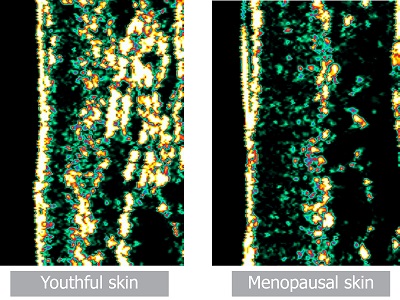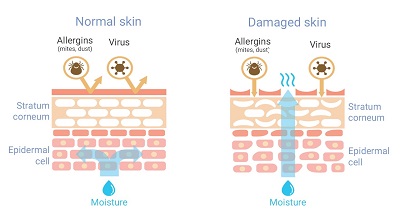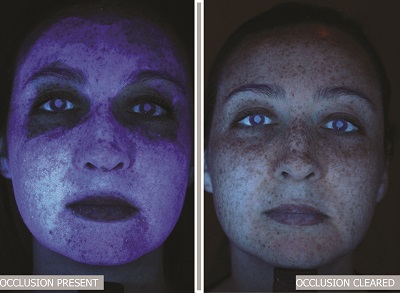Skin Care Considerations for Menopausal Skin
Written by Robert P. ManzoMenopausal skin has a unique set of challenges that should be addressed prior to the onset of perimenopause. Perimenopause and menopause in general can start in the late forties and last for several years. One of the key changes in the skin during this period is the change in systemic hormonal levels. Estrogen levels decrease dramatically, which cause a ripple effect in the skin’s anatomy and physiology. This change, along with others, can lead to clinically thinner skin, a less hydrated skin surface, a reduction of collagen and elastin production in skin, oil patches on the skin, acne breakouts and skin redness, and what appears to be rosacea.
Below is a dermal ultrasound image of the skin. These images represent the dermal tissue where the collagen and elastin are concentrated and which support the skin structure. Loss of collagen and elastin can lead to wrinkles and sagging in skin. You can see on the left dermal ultrasound image that throughout the skin’s dermal tissue there is activity and it is filled with collagen and elastin. In the dermal ultrasound image on the right you can see that in menopausal skin the active collagen and elastin is much reduced.

UNDERSTANDING HORMONAL SHIFTS
Basic hormonal shifts during this period are key to understanding these changes. As estrogen decreases rapidly, the androgens in skin (testosterone) tend to stay constant. This may lead to a condition called the androgenic effect. This includes oilier patches on skin, more vellus hair on the face, and thinning hair on the scalp. Acne can also appear on the skin due to these factors. These shifts tend to happen gradually but are often recognized suddenly.
As a result of the slower production of collagen and elastin and also lipids, as well as volume loss from underlying fat reduction in the skin, wrinkles and sagging skin may evolve. As the skin thins, ultraviolet damage from the sun becomes another important factor to consider when treating menopausal skin.
One other important factor to consider is that as women age, the pH of the skin tends to rise. As that pH shift occurs, the barrier of the skin becomes impaired and, therefore, the skin will become more reactive, dry, and sensitive. As you can see, when the barrier becomes impaired, the skin will allow significant water loss to occur and allow toxins to enter, increasing skin reactivity.

It is very important when treating perimenopausal and menopausal women to look at the client with these basic shifts as a whole with a common root cause. Treating symptoms as they arise one at a time will not be a successful approach and will leave the client unsatisfied.
TREATING PERIMENOPAUSAL AND MENOPAUSAL SKIN
Hormone replacement therapy will not be discussed in this article but has an important place in the process of modulating the symptoms of menopause. It is a controversial and a very individualized process to manage each woman’s needs and wants based on her own symptoms. Women should seek reputable physicians who specialize in this field very carefully.
The table that follows this section is meant to be a quick reference guide in how to treat these symptoms as they arise and within the scope of treating the whole patient. The focus is on the condition of the skin and the ingredients or combinations of ingredients that are most effective to treat them.
The concept of occluded skin is very important to understand when treating any skin surface. Skin occlusion is the condition of skin which occurs when a topical product is applied that coats the skin and prevents anything from penetrating or leaving the skin. This property is desirable when treating skin which is wounded, has undergone a deeper laser or other ablative procedure, or has a barrier that is very highly compromised. The challenge is that if a topical product leaves behind a coating on the skin, active ingredients cannot penetrate it and, therefore, will not work. This includes all serums and specified moisturizers.

Thanks to ultraviolet imaging, you can see on the left side of the image that there is a thick occlusive coating on the skin, visible as an opaque, white layer. Occlusion prevents active serums and products from becoming bioavailable in the skin and makes them much less effective. On the right side of the image, you can see that once the occlusion has been cleared with the proper cleansers, the coating is removed and the client’s skin is both visible and treatable.
One easy way to identify cleansers with occlusive ingredients without having a specialized imaging system like the one used above is to hold the product up to a light source and examine whether they are transparent or cloudy. If a product appears cloudy, white, or pearlescent, chances are it contains ingredients that will build up and occlude the skin. The lesson here is to use clear, transparent products regardless of the actual color.
The chart below guides you through various symptoms that peri-menopausal skin has and how to select the proper ingredient to remediate or control symptoms the best way possible. Remember to combine modalities of treatment for the most effective outcome.
Techniques to be cautious with include microdermabrasion, dermaplaning, hydrodermabrasion, non-ablative lasers, and microneedling.
Any technique that further affects the barrier function of the skin will contribute to a less effective technique for the resolution of your clients’ challenges.
|
Symptom/Condition |
Most Effective Ingredients |
Important to Know |
|
Barrier Function |
Targeted bio-peptides (Note: most peptides will not rebuild the barrier). |
Feeling skin stinging, burning, and sensitivity are all indicative of barrier function impairment. Solve barrier issues first, then, solve secondary symptoms. |
|
|
Hyaluronic acid, but only low to mid-size molecular weight. High molecular weight does not penetrate. |
Ceramides and topically applied lipids rarely work to rebuild barrier in the long-term because they cannot penetrate skin. |
|
Wrinkles and Sagging Skin |
There are specific peptides that start collagen and elastin synthesis. Caution: the dose in the product and the type of peptides are critical. |
To improve wrinkles requires that the products you use have higher levels of active ingredients, which tend to be more expensive. Use better products but read the ingredient labels. |
|
|
Keeping the skin well hydrated with a combination of glycerin, hyaluronic acid, and dimethicone is optimal. |
In general stay away from products which have growth factors in them – there are products that work just as well, if not better. |
|
Redness |
Barrier repair lipids, such as ceramides, but in encapsulated form; anti-inflammatories, such as avenanthramides, and bacteriostats, such as farnesol. |
As the barrier function of the skin starts to become impaired, redness, blotchiness, and blemishes can occur. Also skin bacteria can start to be more populus, which can lead to redness sometimes mistaken as rosacea. |
|
Excess Oil and Blemishes |
Use 5 alpha-reductase compounds, not alcohol or toners, which can initiate a rebound effect. |
Due to higher ratio of androgens and lower estrogens, oil can increase. |
|
Dryness |
Most effective is a combination of glycerin, hyaluronic acid, and dimethicone together. |
Due to the nature of the dryness, a multiple complex of moisturizers is required. |
|
Ultraviolet Exposure |
Broad-spectrum physical sunscreens with a minimum of SPF 35, such as titanium dioxide and zinc oxide, with blue light, infrared light free radical scavengers. |
Due to thin skin, extra attention to ultraviolet, blue light, and infrared light protection becomes very important to help prevent light damage both indoors and outdoors. |
 Robert P. Manzo is the president and chief formulation chemist at Skinprint. He founded Skinprint in 2002 as a cosmeceutical company focused on personalized skin care solutions for providers. Manzo holds 15 patents in skin care and associated fields, including a patent on customized skin care processes. He continues to speak and train medical-based skin care audiences internationally and publishes in trade journals and periodicals regularly.
Robert P. Manzo is the president and chief formulation chemist at Skinprint. He founded Skinprint in 2002 as a cosmeceutical company focused on personalized skin care solutions for providers. Manzo holds 15 patents in skin care and associated fields, including a patent on customized skin care processes. He continues to speak and train medical-based skin care audiences internationally and publishes in trade journals and periodicals regularly.
